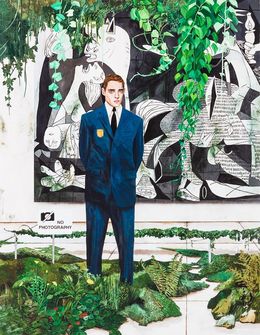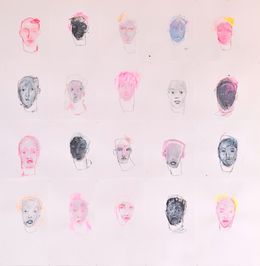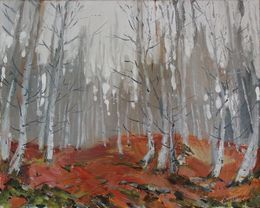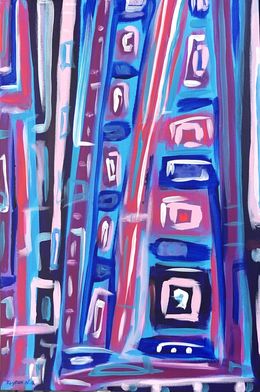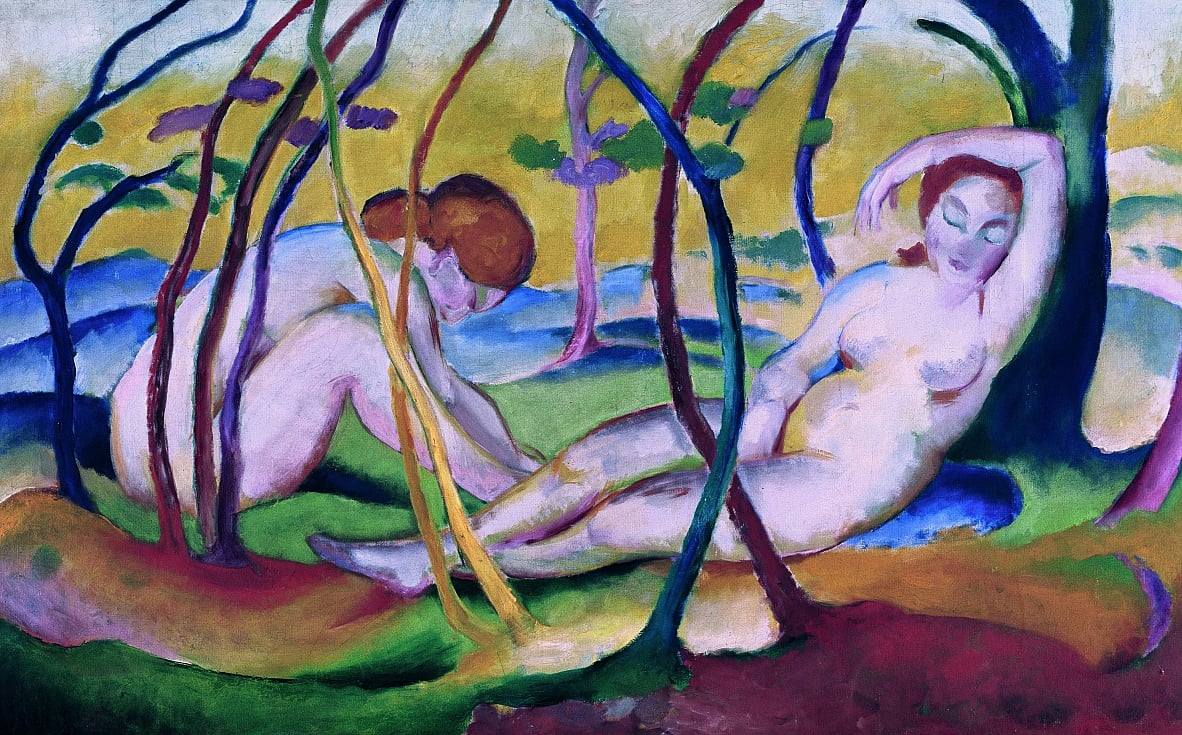
A History of Female Nude Paintings

Representing the human body has been one of the major themes throughout art history since prehistoric times. In fact, among the paintings that have marked history, many are nude paintings of bodies, more specifically naked woman. We can take as an example Botticelli’s The Birth of Venus, Courbet’s The Origin of the World or Modigliani’s Reclining Nude. The nude genre can be assimilated to a large number of pictorial subjects, the most famous including Matisse and Ingres’ “odalisques”, Renoir’s and Cézanne’s “bathers” or the “Olympia” of Manet and Magritte.
The body is a fantastic source of inspiration for an artist because it is simultaneously the embodiment of beauty, desire, reverie and the forbidden. And it is often the nude paintings that cause scandal in art. Over the centuries and across movements, nude paintings have created an aesthetic of the body and beauty. Beyond the subject represented, the painters create imagery of the human body, often very personal and sometimes even against the artistic rules of their time. Let Artsper take you on the journey of a brief history of the women nude painting through art…
1. Middle Ages and Pre-Renaissance: The Sacred Nude
In the Middle Ages, the Church used the nude to show the vulnerability of man, aware of the importance of the image in teaching religion to the illiterate. The Church commissioned artists to paint frescoes, sculptures and paintings to decorate their churches and religious manuscripts. Contemporarily, art was mainly for religious purposes, with the nude being considered sinful. It referred to the mortal and imperfect condition of man. Nude paintings were thus represented for iconographic reasons. For instance, naked characters are found on the tympanums of churches alluding to the Underworld. The biblical figures Adam and Eve are synonymous with nudity and sin. They are often represented in their simplest form, with snakes or leaves covering their genitals. These naked bodies, although visually very close to profane nudes, are in fact in service of the sacred.
Masaccio

In 1425, the Italian painter Masaccio created a fresco representing Adam and Eve driven out of Eden, for the church of Santa Maria del Carmine in Florence. While Adam lowers his eyes and hides his face, Eve hides her nakedness, her eyes spinning and her mouth open as if she were screaming. Above them, we see an angel dressed in red who points to the exit. The two characters are bent over, ashamed and afraid to leave Eden.
Masolino
Opposite this image in the same chapel is the fresco of the painter Masolino. Known as The Original Sin, the fresco was created in 1424. Adam and Eve look at each other with an air of serenity, standing tall and majestic. A light emanates from the figures, the dark background highlighting the bodies and their ancient stature.

It is interesting to compare these two frescoes. Masolino’s Eden is idyllic, Adam and Eve are beautiful and bright. Conversely, in Masaccio’s, Adam and Eve are being terrorized. The difference in the representation of the nude, idealized for one and realistic for the other, highlights the condition of man before and after committing the first sin.
2. Renaissance: Revealing the body
From the Renaissance era onwards, nude paintings began to lose their iconographic character and became valued solely for their aesthetic and sensual qualities. During this period, the rediscovery of Antiquity and an interest in plastic beauty led artists to value the nude itself, which became a key source of inspiration. Artists painted the human body using live models while respecting proportions. They took up the ideal body invented by the Greeks, yet added a more realistic male musculature.
Leonardo da Vinci’s Vitruvian Man is a typical example of the anatomical research of the artists of the time.

Botticelli

In 1485, Botticelli became the first artist to paint a female nude without a religious reason. Nothing like it had been seen before in Europe! It is an almost life-size female nude, measuring 172.5 by 278.5 centimetres, and is a representation of Venus who gracefully reveals her body.
To avoid censorship, Botticelli folds Venus’ long hair over her genitalia. One of her hands hides a breast, but the other remains visible. Her modesty is barely concealed by these two gestures, which only partially hide her feminine curves. It is a game between what she hides and what she exposes, with this idea introducing an erotic dimension to the painting. Her position is inspired by the ancient “contrapposto” in which one of the legs is stretched out, the other slightly bent. This serves to emphasize her hips and her slender figure. Contrary to more classical portraits where the feet are well anchored to the ground, Venus’ balance appears unstable.
She has a pensive look. It is difficult to know what she is thinking about, perhaps she is awakening from a dream? Behind her, the sea is calm with only a few ripples, no storm appears on the horizon and the breeze is gentle.
Botticelli was at the height of his career when he painted this picture, at the request of rich patrons, breaking with convention. His Venus is the graceful, elegant nude, far from any sacred and religious claims, far removed from the tradition of the Middle Ages.
3. Mannerism and Rococo: The Libertine Body
It is during the Mannerist period of the 16th and 17th centuries that nude paintings truly became freed from all constraints or religious considerations. Mannerism offered huge freedom in the representation of the body. Between the form exaggeration and bodily distortion, a strong sense of eroticism emerged.
Agnolo Bronzino

Dating from 1550, Agnolo Bronzino’s painting entitled Allegory of the Triumph of Venus is one of the leading examples of Mannerism. The graceful curves of this immodest Venus trace, on the diagonal of the painting, a “serpentine” line typical of this aesthetic trend: curves and counter-curves that soften the bodies of the figures represented.

Here is a painting that religious morality would doubtlessly disapprove of! Underneath this charming spectacle is an incestuous scene, a kiss between Venus, the goddess of beauty, and her son Cupid, the incarnation of love. Provocative, unseemly, disturbing… There was no shortage of words to describe this scene that goes against all morality.
Against the current of the Renaissance, this movement rejects both the ancient canons and classical thinking, in order to glorify arabesques and artificiality. The Rococo style was also a source of inspiration for nude artists. Indeed, the Rococo painters celebrated the beauty of the body better than anyone through their bold nude paintings.
Jean-Honoré Fragonard

Jean-Honoré Fragonard painted great landscapes, religious and mythological paintings. Yet he is considered the painter of frivolity and Rococo. The Shirt Removed from 1770 is undoubtedly one of the artist’s most iconic and sensual works. In the center, a naked woman lies down and a “putto”, a servant of the goddess Venus, removes her blouse. The painting presents a daring subject, even if the closed eyes and the half-turned body evoke a certain modesty. Here, the nude is sublimated by the white, gray and pink colors that highlight the young skin of this woman. Moving away from mythological and historical subjects, Fragonard revolutionized the genre in creating these intimate and frivolous nude paintings.
4. Romanticism and Realism: The Nude in total rupture
The Romantic era came with a desire to portray reality, although without hesitating to dramatize it. This period marks the arrival of exoticism and the fantasy of harems. Nude paintings then became liberated and even began to evoke sexuality. Romanticism broke ties completely with classicism and neoclassicism by rejecting formal conventions. It was no longer the forms and subjects that are highlighted, but rather the intensity of colors, contrasts and light.
Francisco de Goya

In 1790, Francisco de Goya showed, likely for the first time, the pubic hair of a real woman and not of a goddess or nymph in his painting La maja desnuda. The artist created the nude without any other justification than the pleasure of revealing herself. The naked woman has a confident look and stares directly at the viewer without shame or shyness. This painting, which represents the Spanish painter’s mistress, was commissioned privately and was supposed to be hidden from public view. It was nevertheless discovered and shocked society at the time!
Realist painters often focused on nudes taken from their daily lives. Their models were from the so-called lower social classes: prostitutes, actresses or lovers.
Gustave Courbet

Of course, we cannot forget the painting The Origin of the World by Gustave Courbet, which caused a scandal with the public and at the Salons in 1866. Without censorship, it represents the female vagina. Courbet rejected academic painting and its idyllic, idealized versions of the nude. His painting always challenged the limits of the presentable.
5. Impressionism: The Women Nude in all its splendor
Impressionist painters are credited with revisiting the nude. By removing the edges and contours of the body, they focus on color and brush strokes to give an energy and vitality to the bodies. It is within Impressionist painting that nudes caused the most scandal. Many artists painted ordinary women, usually in their simplest form. Impressionist artists represent the nude in a variety of ways.
Edouard Manet

In 1863, with his two paintings Olympia and Déjeuner sur l’herbe, Edouard Manet radically rejected the academic norms of the time. The Modern painter wanted to represent the reality of his time: Olympia is a prostitute, and not a mythological goddess or a nymph. He painted this reality without trying to idealize it. However, in the mid-19th century, depicting a nude was only permissible if situated in an exotic or mythological space. Here, the nude woman is strongly individualized and provocative. She stares at the viewer: it is this direct gaze and expression of indifference that causes a scandal. In the academic paintings, the naked female figures are “surprised”, as if somebody has walked in on her in the nude. Ultimately, they do not show themselves voluntarily naked. However, Olympia contradicts this idea.
Edgar Degas
Nude figures are also at the heart of Edgar Degas‘ work. The nude is his favorite subject because it is the genre in which he innovates the most: these nudes reflect the variety of techniques that Degas seizes. He employed drawing and painting, but above all pastel, which he appreciated for its speed of execution and the possibility of copying the painting without the pastel drying.

In The Tub of 1886, the position of the woman, the still life with the toiletries, the false perspective and the overhang make this pastel one of the most masterful nude compositions of Degas’ work and of the period.
Paul Cézanne
How can we talk about artistic nudes without mentioning those of Paul Cézanne? Between his temptresses of Saint Anthony and his bathers, the artist poses a tormented vision of women.

In his painting The Temptation of Saint Anthony, Cézanne portrays a dark expression through women with greenish, sickly skin. The figure of St. Anthony, who is usually in the center, is relegated to the left of the painting, barely visible. Our gaze is inevitably drawn to these three women with robust bodies, large bellies and breasts. To the left, the fourth figure, less illuminated, dances in front of Saint Anthony. This painting gives a pessimistic impression through the use of light contrasts, dark colors (brown, gray, yellowish and dark green) and grotesque figures: note the masculine features of the woman on the right.
At the time, Cézanne could not convince himself to invite real women to pose nude for him. Some critics believe that through this painting, Cézanne wanted to represent his fear of women, as a kind of harassment of these female bodies that make him so uncomfortable.
These provocative figures later gave way to the figures of the bathers. Through this painting Bathers, Cézanne wanted to invent his own system of representation. He seeked to deconstruct the subjects by removing all narrative and descriptive elements, then to reconstruct them by simplifying their forms to the extreme. We don’t know who these women are, due to their faces being only partially painted. Moreover, shapes and colors are blended on the surface of the canvas, creating a fusion between the women and the landscape. One thing for certain is that these nudes are rather revolutionary, paving the way to abstraction.

6. Expressionism: Women Nudes in torment
Egon Schiele
The German Expressionist movement also featured many nudes. The friend of Gustav Klimt, Egon Schiele was a major Expressionist painter, the most scandalous of the early 20th century. His work is marked by an intense sexuality, colliding with the classicism and bourgeois conventions of the time. His very singular style is recognizable by the twisted shapes of the body and the expressive lines.

In 1910, Schiele began to experiment with the nude and portrayed emaciated figures in sickly colors. Female Nude is a perfect example: a naked woman in a dislocated position, presenting a thin, corpse-like body. The solitude of the subject is reinforced by the plain background and the white halo surrounding the body. The half-closed eyes and the hand are almost reminiscent of a mortuary figure, recalling the artist’s connection between sexuality and death. But this Schiele nude is at the same time all-powerful! The disheveled hair and the piercing look, the ochre and red colors employed and the light that emanates from it make this work a strong and subjugating scene.
Schiele’s nudes are linked to psychoanalysis, which was taking off at that time. The naked body is the vehicle for the artist’s existential anguish. His subjects convey the duality of the body, both a source of sexual impulses and a symbol of death. At the beginning of the 20th century, Schiele was described as a pornographer, a psychopath and even a demon because of his nudes, which were considered to be far too scandalous…
Otto Dix
A direct witness to the great horrors of the 20th century, Otto Dix never stopped criticizing the violence and absurdity of his time through his painting. He was fascinated by ugliness, bad taste, the macabre and grotesque situations. The artist paints tortured women, war widows and prostitutes.

In Half-Naked, Otto Dix is captivated by the body of this woman, who tries to modestly conceal her nudity. A feeling of unease and embarrassment emanates from this painting. Through this woman trying to hide her body, her heavy breasts, her overly made-up face and miserable expression, Otto Dix tries to give us a representation of his world which is, according to him, purely ugly and atrocious.
7. Contemporary Art: The Nude in all its forms
Tom Wesselmann
After the Second World War, artists reappropriated the nude in a very individualized way. Tom Wesselmann, an American artist and major figure of the Pop Art movement, created female nudes using images cut out from magazines and found objects. Provocative and depersonalized, his works have become true erotic icons, emblematic of the 1960s. Wesselmann wanted his nudes to provoke strong reactions. He once said “the nude, I think, is a good way to be aggressive, figuratively speaking. I want to elicit intense and explosive reactions from viewers. “

Hildegarde Handsaeme
Hildegarde Handsaeme‘s nude paintings are true odes to women. The body is poetic and colorful, similar to what the cubists did in their time. The nudity is frank, the shapes generous. These bodies with fine contours, dominated by curves, are highlighted by the flat areas of color spotted around the piece. Her work is very personal and shows that art and the nude have no boundaries, are elusive and difficult to put into words.

Since the Modern period, the nude painting has essentially evoked the female body, a legacy of painters (and a society!) who rendered it an object of male desire. However, at the time – and here is the paradox – the female body was less valued than its male counterpart, more athletic and muscular.
Eternal representation of the Female Nude
Finally, the representation of the female body in Western painting since the Middle Ages has brought fame to some of the world’s greatest artists. Sometimes religious and sacred, sometimes uninhibited and Libertine, artists have represented the female nude in thousands of ways. Depending on the period, the nude can symbolize the innocence or humiliation of Eve, the beauty of an ancient divinity or the Libertine of the 18th century. What’s your favorite female nude painting?

About Artsper
Founded in 2013, Artsper is an online marketplace for contemporary art. Partnering with 1,800 professional art galleries around the world, it makes discovering and acquiring art accessible to all.
Learn more



